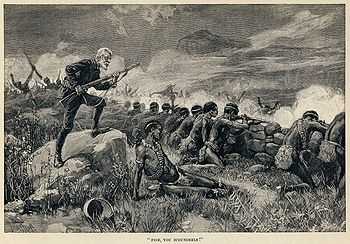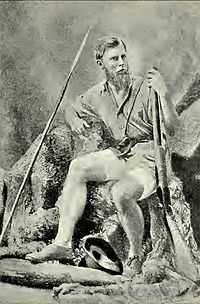4 bore
| 4 bore | |
|---|---|
|
Portrait of Frederick Courteney Selous with his 4 bore single-shot smoothbore gun and African hunting regalia, 1876. | |
| Type | Rifle or Smoothbore, Heavy Game |
| Place of origin |
|
| Specifications | |
| Case length | 4 in (100 mm) |
Four bore or 4 bore is an obsolete black powder caliber of the 19th century, used for the hunting of large and potentially dangerous game animals. The specifications place this caliber between the larger two bore and the lesser six bore. This caliber was the quintessential elephant gun caliber of the black powder safari rifles.[1]
Specifications
The name derives out of an old English practice of bore measurements in gunmaking, meaning a perfectly round pure lead ball that exactly fits the bore of the weapon would weigh 1/4 lb—that is, 0.25 lb (0.11 kg) (see gauge). The 4 bore was made to fire roundballs of 1/4 pound lead, or approximately 1750 grains (1750 gr.) and approximately 1-inch (25 mm) calibre (more precisely, 1.053-inch (26.7 mm), when shooting pure lead bullets). This varied greatly as in muzzle loader days shotgun gauges were custom made and often differed from the actual bore measurements. Commonly, 4 gauges were closer to .935–.955 calibre, pertaining to a 1400 gr. alloyed lead ball and closer to 5 gauge.
History 1750–1880

As European settlers found early on, their regular muskets were inadequate against dangerous African game. Early gun adaptations were to use smoothbore shotguns with extra long barrels and round balls. By the mid-19th century, 12, 10, 8 and 4 bore muskets had been strengthened and bulked up for much larger charges. Shooting dangerous game was still at this stage as much about being able to gallop away on horseback to reload and fire again, some times up to 30 times when after an elephant.
The first 4 bores were probably single barrel muzzleloaders converted from British fowling pieces that were, in essence, slug guns. Loads (bullet weights and gunpowder loads) varied greatly. As the weight and strength increased, gunpowder loads went from 8 drams (0.5 oz) to a full ounce (16 drams), or more, of powder. The advent of rifling after about 1860 allowed longer conical projectiles to be stabilised, and, aside from accuracy, these provided even greater weight and penetration, with some hardened lead or steel bullets weighing as much as 2000 grains. The 4 bore was also occasionally used for shooting exploding projectiles. Although 4-bore firearms were commonly referred to as "rifles", smoothbore version of the weapon were actually more popular, and continued to be so throughout the era of four bore usage. Since dangerous game was shot at ranges under 40 yards, a smoothbore was sufficiently accurate, while at the same time providing higher velocities and lower recoil, and needing less cleaning. The prominent British gunmaker W. W. Greener even recommended against rifled firearms above the bore size of eight, with the four bores that he continued producing from then on being exclusively smoothbores.[2] The smoothbore also, at least until the advent of breechloading, could be reloaded faster.
Many famous elephant hunters during the 19th century used such weapons, including George P. Sanderson in India and William Finaughty and Frederick Courteney Selous in Southern Africa.[2] Sanderson, in particular, mentioned two each four bore firearms that he used, one of which was rifled while the other was not. Although both weapons were of similar weights, the rifle was built to accommodate only one barrel with a powder charge only five-sixths that of the smoothbore, which was a double-barrel. Sanderson, in fact, discarded the rifle after a misfire of the weapon's cartridge almost led to his death, and the instance demonstrated the superiority of the smoothbore over the rifle in the case of an oversized firearm in his day in his mind.[3] With the advent of breechloading cases in the late 19th century the 4 bore came into its current guise, that being the well-known 4–4.5" brass case.
The cartridge brass case was around 4 inches (100 mm) long, and contained three types of loads: light at 12 drams, 14 drams at regular, and 16 drams of powder at heavy load. (Note: 1 dram = 27.34375 grains in the avoirdupois system, since 256 drams = 7000 grains = 1 pound of powder. Shotgun shells are still rated in terms of the same archaic dram measurements, relative to their equivalence of smokeless powder load to a black-powder load weighed in drams.) John "Pondoro" Taylor mentioned in his book African Rifles and Cartridges that the 12 drams (328 gr., 3/4 oz.) charge would propel the projectile at around 1,330 ft/s (410 m/s).[4] A double barreled rifle that would fire such a calibre would weight around 22–24 lb bare, while the single-barreled version would be around 17–18 lb.[5] In common practice, the cartridge cases were not typically reloaded, as reliability was of the utmost importance, more important than a possible false cost savings from an attempt at reloading that might cost a hunter his life. Bullet lubrication was typically mostly beeswax based, such that in hot tropical climes there could be no possibility of a bullet lube melting from the base of the bullet, ruining the charge of powder within the cartridge. Reliability was the utmost concern.
Golden Age and later usage
This caliber was used heavily by the European hunters, notably so the British and Dutch Boers, in tropical climates of Africa and India. A single barreled smoothbore percussion cap musket of between four to six gauge called a "roah" was the standard weapon among Boer hunters, until the common acceptance of breechloading rifles among their ranks in the 1850s. Many of the earliest British hunters adopted this practice from the Boers, with Selous being the best known among them.
Meant to be used with black powder due to its size, it was unpopular due to the problem of thick smoke and a powerful recoil. Notable hunters that used the rifles included Sir Samuel White Baker and Frederick Selous, who used it consistently in his career as an ivory hunter of African elephants between 1874 and 1876 until the advent of the lighter, more accurate and less cumbersome Nitro Express calibers and cordite propellant. In the mid-1870s, Selous favoured a four bore black powder muzzleloader for killing elephant, a 13 lb (5.9 kg) short barreled musket firing a quarter pound bullet with as much as 20 drams (540 grains) of black powder. He could wield it even from horseback. Between 1874 and 1876, he slew exactly seventy-eight elephants with that gun, but eventually there was a double loading incident together with other recoil problems. He finally gave it up, due to it "upsetting my nerve".

Although a weapon of immense power, the four bore was far less effective than its Nitro Express successors because of the low penetration of its projectiles and its immense recoil. The huge lead slugs fired by the gun were sometimes capable of stunning a charging African elephant to stop it on its tracks, or turn its charge (causing it to change direction to avoid the hunter) but it was generally unable to kill the creature outright with a frontal brain shot.[2] Chest and broadside shots were effective killers, as was the side shot on brain where the skull is thinner on elephant, however once again this did not help for instantly stopping an enraged elephant charging the hunter. On the other dangerous game species such as the Indian elephant, buffalo species and Rhino it was considered an excellent killer. The use of four bore elephant guns in fiction, such as in Allan Quatermain, the sequel to King Solomon's Mines, was a common theme during the Golden Age of African hunting and in Lost World type adventure stories published in the late 19th Century and early 20th Century. The four bore also figures prominently in more recent fiction, such as Unintended Consequences.[6]
Stanley carried a 4 bore rolling block single shot rifle on his expedition to find Dr Livingstone.[7]
See also
Notes
- ↑ "Return of the 4 bore".
- ↑ 2.0 2.1 2.2 Ganyana. "Classic African Cartridges: The Giant Bores 4 And 6". African Hunter Magazine.
- ↑ Sanderson, G. P. Thirteen Years among the Wild Beasts of India.
- ↑ Taylor, John H. African Rifles and Cartridges.
- ↑ Ross Seyfried (July–August 2001). "The Most Powerful Rifles on Earth". Rifle 33 (4). ISSN 0162-3583.
- ↑ "Frequently Asked Questions". John-Ross.net.
- ↑ "The rifle at NRA's museum". NRA.
